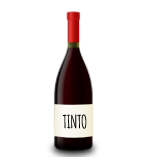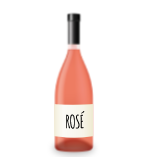Types Of Wines
All types of wine that you can find in our store

Red Wine
Red wine is obtained from the fermentation of red grapes. In its production, it is crucial that skins and must remain in contact so that the liquid acquires colour.
It is common to classify red wines according to their ageing period, that is to say, according to the time they have rested in the cellar after fermentation:
- Young red wine when it has been bottled a few months after it has become wine and without having been in barrels or having done so very briefly; it preserves the primary aromas intact and allows consumption at cooler temperatures.
- Crianza red wine has been aged for at least 24 months, with a minimum of 6 months in oak barrels.
- Reserva red wine is aged for up to 36 months, of which 12 months must be spent in barrels.
- The Gran Reserva red wine has 60 months of total ageing, with at least 18 months in barrel and the rest in bottle.
- The longer the time spent in contact with the wood, the more relevant the toasted and spicy aromas will be in the wine.
The classification by ageing period is very common in Rioja and Ribera del Duero, so we can find:
- Tinto Rioja Crianza, aged for a minimum of 12 months in oak barrels and the rest in bottle.
- Tinto Rioja Reserva, aged in oak barrels and bottle for a minimum of 36 months in total.
- Tinto Rioja Gran Reserva, 62 months of ageing.
- Tinto Ribera del Duero Roble, aged in oak barrels for 3 to 9 months.
- Tinto Ribera del Duero Crianza, with a minimum of 12 months in oak barrels.
- Tinto Ribera del Duero Reserva, 36 months between oak and bottle ageing.
- Tinto Ribera del Duero Gran Reserva, aged for 60 months.

Rosé Wine
Rosé wine is produced from red grapes or by blending red and white grapes, whose fermentation takes place without the presence of the skins.
The two basic systems for obtaining rosé wines are pressing and saignée. Both start with destemmed and crushed grapes, i.e. without stems and with the skins broken so that the must is released. In both cases, once the must has been separated from the skins and seeds, a fermentation process begins as if it were a white wine.
In the first case (pressed), the wines have a very subtle colouring, as the skins and must have had very brief contact before pressing.
The rosé of saignée is obtained by vatting the grapes and leaving them in the vat in contact with the skins until a drained must of the desired colour flows.
A third option to obtain rosé wine is to add red wine to white wine. This formula, banned in the EU, results in wines of lower quality.

Vino blanco
White wine obtained from white grapes after little or no maceration. Its fermentation does not involve the skins, which explains the low intensity of its colour. It is also possible to make white wine from red grapes if the contact of the skins with the must is kept to a minimum, although this practice is more common in sparkling wines.
White wine that undergoes malolactic fermentation and/or ageing in wood tends to be more oily and to incorporate spicy and buttery aromas that make it particularly gastronomic.
When we talk about white wines, we often tend to talk about grapes, and we associate these single- varietal wines to types of wine, for example:
Vino Orange
Orange wine is a white wine made as if it were a red wine; it is also known as "brisado". It is made from white grapes and its skin and must are left to macerate and ferment together so that the wine acquires an orange hue. This process can last from a few days to several months.
They are wines with structure and a more tannic feel than conventional white wines, usually produced by natural winemakers. Their colour is not always orange and can vary from deep golden to amber, especially when aged in vats or barrels.
Sparkling wines
Sparkling wine, with bubbles, usually white or rosé. It can be obtained from a double fermentation (traditional method or charmat method) or with only one fermentation (ancestral method).
Champagne or Cava, for example, are sparkling wines with double fermentation. This means that they are first fermented in a tank and then undergo a second fermentation in the bottle, according to a process known as the traditional method. They are considered the most delicate and complex sparkling wines.
Most Italian Prosecco or German Sekt, on the other hand, undergo both fermentations in tank, following a method known as Charmat. Their bubbles are not as refined as those of traditional method wines, but their aromas are more direct and fruity.
Finally, the Ancestral Wines, develop a single fermentation, which will begin in tank and will conclude in bottle. These wines are highly digestible, sparkling and very versatile at the table.
Sparkling wines can also be classified according to the residual sugar they contain or their colour. In our shop you can find Cava rosé or Champagne rosé, but also Cava brut, Cava brut nature or Champagne brut.
Sweet wine
Sweet wine has an important sugar content, strictly speaking, higher than 50 gr/l. Sweet wines are basically divided into two large families: natural sweet wine and naturally sweet wine.
We speak of natural sweet wine (NSW) when wine alcohol has been added to stop fermentation, thus achieving a higher alcohol content and at the same time a residual sugar that will be responsible for its sweetness. Banyuls belong to this category.
Naturally sweet wine (VND) is a wine whose only sugar/alcohol comes from the grapes from which it is made. To make it, the grapes are harvested late or left to dry in the sun to dehydrate. Subsequently, fermentation begins, which is sometimes stopped spontaneously and sometimes by cold or other methods. Its alcoholic content is lower than that of natural sweet wines, as both alcoholic content and sweetness are obtained from a single source of sugar. Moscato d'Asti is the perfect example of this type of wine. Icewines (Icewine, Eiswein) and botrytis wines (Tokaji, Sauternes) can also be included in this style.
Fortified wine
Dry wine with a high alcohol content (between 15º and 23º) obtained partly by fermentation and partly by the addition of wine alcohol.
Jerez-Manzanilla and Montilla-Moriles are the major fortified wine producing regions in Spain. Fino, Manzanilla, Amontillado, Oloroso and Palo Cortado are fortified wines.
When a fortified wine has a sugar content higher than 5 gr/l, it is called Vino Generoso de Licor (fortified liqueur wine); in this group we can place the Cream from Jerez.
Other interesting fortified wines are: Marsala from Sicily or Porto from Portugal.
Vermout
Vermouth is a white wine infused with botanicals to which wine alcohol is added. Its name comes from the German word wermut, the German name for wormwood, a fundamental herb in the production of Vermouth.
Its great success today lies in an infusion of herbs, roots, flowers, spices and fruit, to which sugar and wine alcohol are usually added.
This mixture is left to mature in barrels until the aromas come together and the whole is harmonious. In addition to absinthe (wormwood), other common ingredients are gentian, cinnamon and orange peel.
